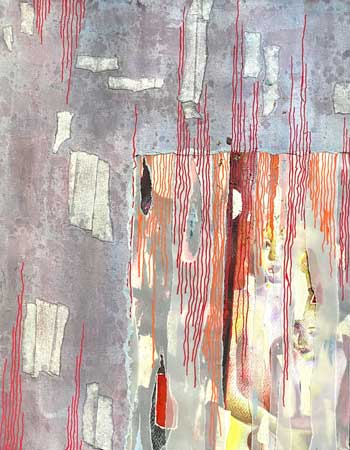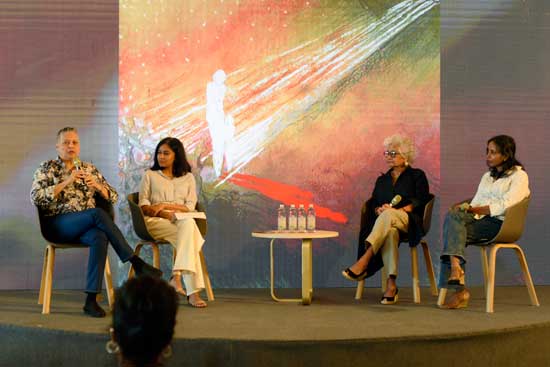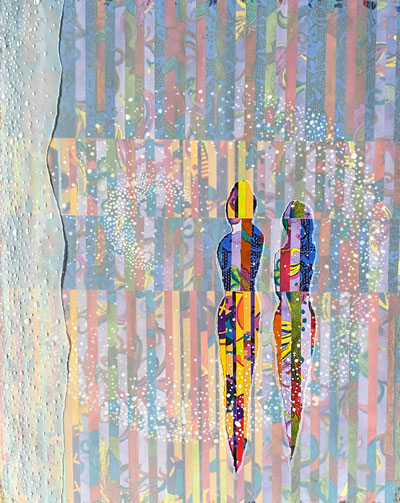
Reframed: The power of women
Original article by Devika Brendon | Published: December 1, 2024

Can I take her first to that bank where the water stills; and then let the gate open, bringing in a myriad outside lives, letting her know of their spirit, and in some way give her a life
Anoma Wijewardene’s latest exhibition took place, appropriately, at The City Of Dreams, the new Cinnamon Life Hotel, during the Sri Lanka Design Festival (SLDF). The artworks were captioned by poetic lines written by Ramya Jirasinghe. There were also contributions by other activists and writers, interspersed with the artworks in the form of placards.
Reflect: Reframe: Renew celebrates the magnificent power embodied in women to overcome the devastation inherent in our experiences of life and emerge transformed, just as the Earth renews itself after every catastrophe.
This series of paintings expressed in a variety of media by the artist Anoma Wijewardene incorporates the writings of the poet Ramya Chamalie Jirasinghe and Jayanthi Kuru Utumpala, the women’s rights activist and mountaineer. Anoma, Ramya and the activist Rosanna Flamer-Caldera participated in a vibrant conversation about creativity and the vital need for creative expression, in a panel discussion moderated with great insight by Radhika Hettiarachchi during the Design Festival.
The theme of the exhibition was ‘Reflect, Reframe, Renew’, and many of the images in the artworks and the words focused on women and feminine energy. These are not at all soft skills: the capacity to reflect, both to mirror the world courageously and to confront the self and its experiences, to journey within, is an introspective process that requires great courage. What happens when we look at what the mirror reflects and are challenged by what we see? Do we gloss it over, or do we regenerate?
Much of female experience in the world involves reframing narratives which exclude or limit us, or narrowly focus on whatever parts of us are deemed attractive or desirable. We are also required to support and console many of the hurt and suffering people in the world, helping them to reframe their sense of self and the trajectory of their life, after trauma or loss.
That recalibration requires a setting aside of the ego, and the understanding that we live not only physically in a material world, run by masculinist viewpoints and machines and money, but simultaneously a spiritual realm, in which our intuition and our energetic awareness and our capacity to imaginatively create and celebrate and wonder are our guides.
Renewal is a process that we as women intimately understand: cycles of body, mind, and spirit define our lives. The natural world with its seasons and prompts, the budding and the blossoming and the shedding, all illustrate renewal. Seen and measured by the utility of our reproductive capacity, we need visual art like this to illustrate our multidimensional regenerative abilities, of healing and mending and again and again, the making of choices which shape the world.

Panel discussion from left: Rosanna Flamer-Caldera, Radhika Hettiarachchi, Anoma Wijewardene and Ramya Jirasinghe
The artworks are visually stunning, both individually and as a sequence. They use techniques of superimposition, which at times make them appear embossed: correlating images like human fingerprints and strands of hair against semi transparent human figures, and the weblike roots and branches of trees. The overall impression is that of Life, streaming through us, in a river of sensations and impressions. Some images look like frogspawn, some like strands of DNA, some like a mosaic of kaleidoscopic waterfalls, some like fragments of tears. Some of the human figures have nimbus-like radiance around their faces and heads. The artworks show us as made of water, and of glass, as Ramya’s poetic captions highlight. They show individual fractals in a collective stream of consciousness.
I had the pleasure a few years ago of doing part of the final copy editing of Anoma’s monograph titled ‘Anoma’, cataloguing and collating her entire life’s work, and this exhibition is a powerful addition to her oeuvre. In keeping with her lifelong preoccupations, it shows that the fragility of our human lives, and our heretofore careless misapprehension of our place in the natural world and the geopolitical spheres, which has led to the climate crisis we currently face, has only one remedy.

Give me one life. A woman: humble, proud, arrogant, lost, drained, searching, mad. A woman redeemed by her core that refused to become a lie.
We must awaken. To return to a sense of alignment and attunement, to ‘return to the heart’s centre’ to co-create, and co-exist. To use our sentience. In the poem ‘Renewal’, Ramya states in words what Anoma’s artwork illustrates: ‘Here every renewal must be self-made.’
Ramya’s poem ‘Deliverance’ expresses a hope that:
‘We will choose instead
The water that springs from
The earth at its darkest hour
And will hold in one
Cupped palm every possibility.
In a moment, on our own,
Each of us will return
To the singing winds
The lucid light and
Call our bodies this earth
This earth our raft.’
The whole experience of attending this exhibition and the discussion was an immersive and flowing one. The volunteer guides, the administrative staff, the interns and trainee curators, the individuals who helped pack and convey and hang the artworks in such an evocative way in the Mercedes Benz Gallery, were all exemplary in their professionalism.
In her artist’s statement for the exhibition, Anoma writes:
These are the best of times and the worst of times for women.
Individual women are breaking glass ceilings, becoming Presidents and Prime Ministers, heading corporations, flying into space as astronauts, winning Nobel prizes in the sciences and fighting on the frontlines with male soldiers.
At the same time violence against women throughout the world is on the rise and the vast majority of women are involved in care work in the family without any relief or support. In war zones they are killed, maimed and cower as bombs and drones destroy their families and every fabric of their society. In some countries they are denied schooling, employment and cannot leave home without a male relative. Women in many strata of society face sexual harassment and abuse with certain cities being notorious for their high incidence of rape.
In all societies they still remain victims of misogyny, dismissed and diminished in everyday life. Yet women comprise 49.72% of the global population.
In that sense the fight for women’s freedom is only beginning.
There is so much more to do.
Read full article – Link

